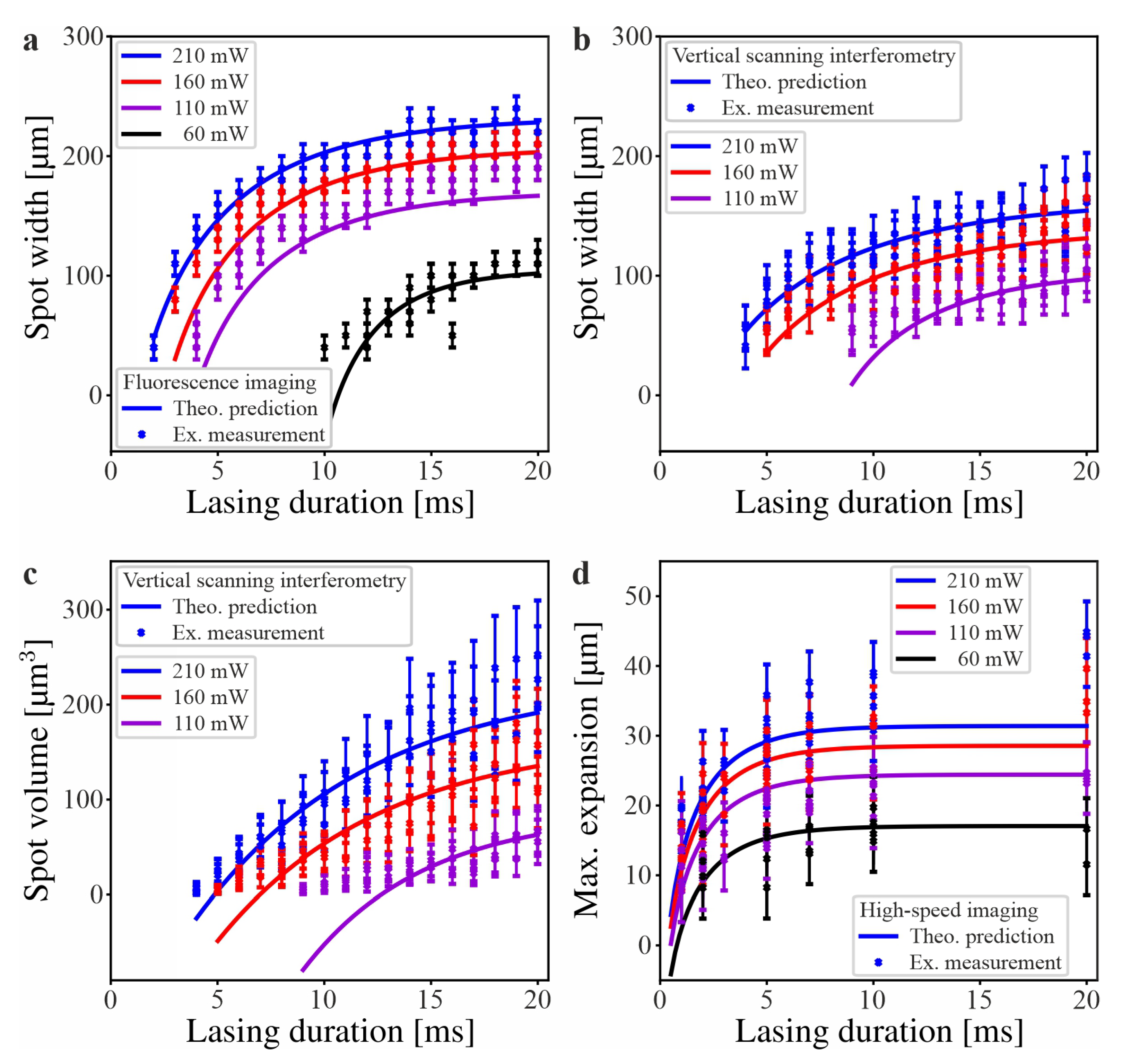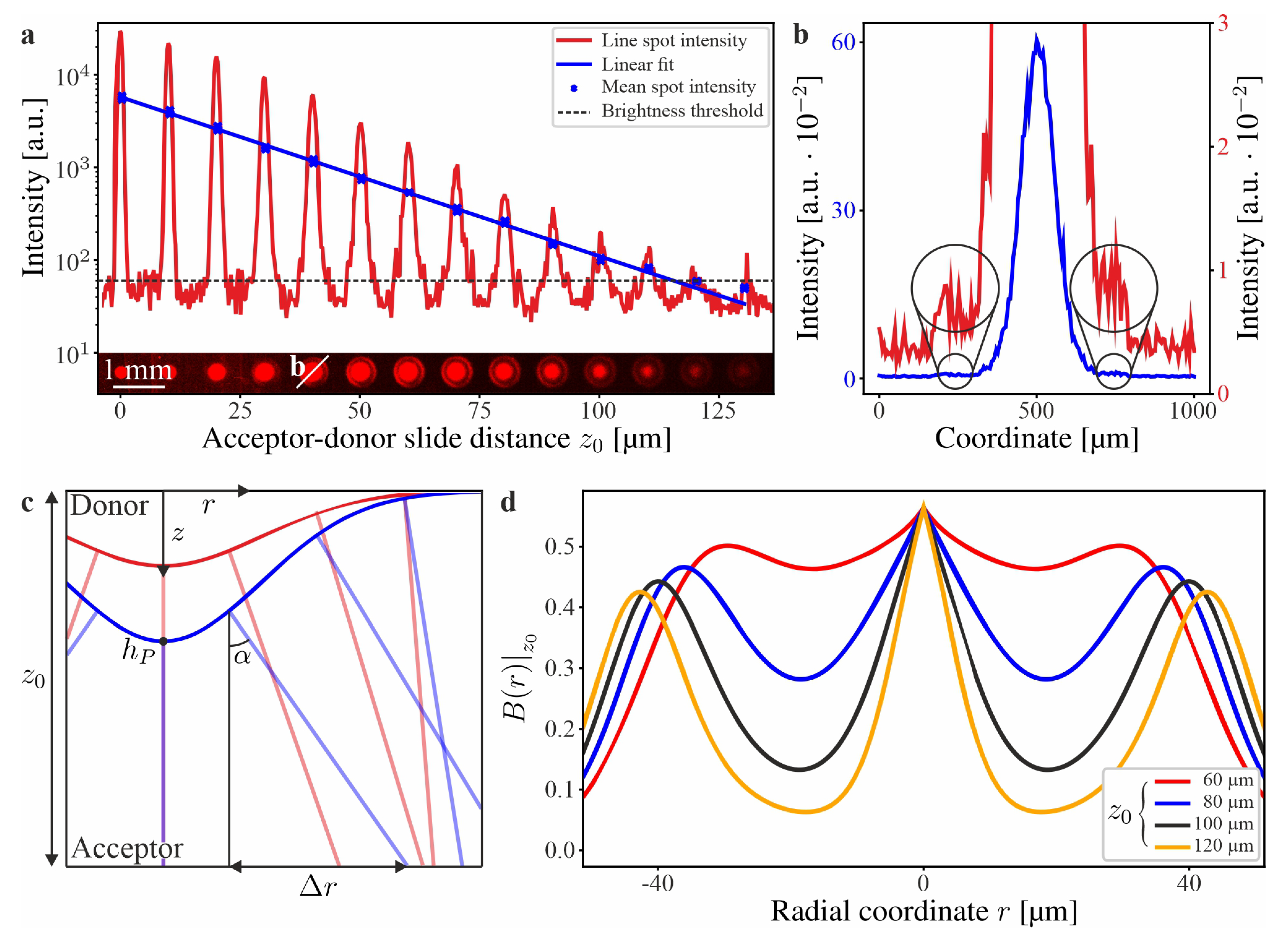Development and Experimental Assessment of a Model for the Material Deposition by Laser-Induced Forward Transfer
Abstract
1. Introduction
2. Materials and Methods
2.1. Lasing Setup
2.2. Donor Substrate Preparation
2.3. Fluorescence Imaging
2.4. Vertical Scanning Interferometry
2.5. High-Speed Imaging
2.6. Spot Evaluation
3. Results and Discussion
3.1. Contact-Based Transfer Mechanism
3.2. Ejection-Based Transfer Mechanism
4. Conclusions
Supplementary Materials
Author Contributions
Funding
Institutional Review Board Statement
Informed Consent Statement
Data Availability Statement
Acknowledgments
Conflicts of Interest
References
- Levene, M.L.; Scott, R.D.; Siryj, B.W. Material transfer recording. Appl. Opt. 1970, 9, 2260–2265. [Google Scholar] [CrossRef]
- Bohandy, J.; Kim, B.F.; Adrian, F.J. Metal deposition from a supported metal film using an excimer laser. J. Appl. Phys. 1986, 60, 1538–1539. [Google Scholar] [CrossRef]
- Bohandy, J.; Kim, B.F.; Adrian, F.J.; Jette, A.N. Metal deposition at 532 nm using a laser transfer technique. J. Appl. Phys. 1988, 63, 1158–1162. [Google Scholar] [CrossRef]
- Zergioti, I.; Mailis, S.; Vainos, N.A.; Fotakis, C.; Chen, S.; Grigoropoulos, C.P. Microdeposition of metals by femtosecond excimer laser. Appl. Surf. Sci. 1998, 127–129, 601–605. [Google Scholar] [CrossRef]
- Willis, D.A.; Grosu, V. Microdroplet deposition by laser-induced forward transfer. Appl. Phys. Lett. 2005, 86, 244103. [Google Scholar] [CrossRef]
- Porneala, C.; Willis, D.A. Observation of nanosecond laser-induced phase explosion in aluminum. Appl. Phys. Lett. 2006, 89, 211121. [Google Scholar] [CrossRef]
- Feinaeugle, M.; Alloncle, A.P.; Delaporte, P.; Sones, C.L.; Eason, R.W. Time-resolved shadowgraph imaging of femtosecond laser-induced forward transfer of solid materials. Appl. Surf. Sci. 2012, 258, 8475–8483. [Google Scholar] [CrossRef]
- Delaporte, P.; Alloncle, A.P. Laser-induced forward transfer: A high resolution additive manufacturing technology. Opt. Laser Technol. 2016, 78, 33–41. [Google Scholar] [CrossRef]
- Piqué, A.; Chrisey, D.B.; Auyeung, R.C.Y.; Fitz-Gerald, J.; Wu, H.D.; McGill, R.A.; Lakeou, S.; Wu, P.K.; Nguyen, V.; Duignan, M. A novel laser transfer process for direct writing of electronic and sensor materials. Appl. Phys. A 1999, 69, 279–284. [Google Scholar] [CrossRef]
- Ringeisen, B.R.; Wu, P.K.; Kim, H.; Piqué, A.; Auyeung, R.Y.C.; Young, H.D.; Chrisey, D.B.; Krizman, D.B. Picoliter-scale protein microarrays by laser direct write. Biotechnol. Prog. 2008, 18, 1126–1129. [Google Scholar] [CrossRef]
- Serra, P.; Colina, M.; Fernández-Pradas, J.M. Preparation of functional DNA microarrays through laser-induced forward transfer. Appl. Phys. Lett. 2004, 85, 1639–1641. [Google Scholar] [CrossRef]
- Serra, P.; Fernández-Pradas, J.M.; Colina, M.; Duocastella, M.; Domínguez, J.; Morenza, J.L. Laser-induced forward Transfer: A Direct-writing Technique for Biosensors Preparation. J. Laser Micro Nanoeng. 2006, 1, 236–242. [Google Scholar] [CrossRef]
- Duocastella, M.; Fernández-Pradas, J.M.; Serra, P.; Morenza, J.L. Jet formation in the laser forward transfer of liquids. J. Appl. Phys. A 2008, 93, 453–456. [Google Scholar] [CrossRef]
- Duocastella, M.; Fernández-Pradas, M.; Morenza, J.L.; Serra, P. Time-resolved imaging of the laser forward transfer of liquids. J. Appl. Phys. 2009, 106, 084907. [Google Scholar] [CrossRef]
- Tolbert, W.A.; Lee, I.Y.S.; Doxtader, M.M.; Ellis, E.W.; Dlott, D.D. High-speed color imaging by laser ablation transfer with a dynamic release layer: Fundamental mechanisms. J. Imag. Sci. 1993, 37, 411–421. [Google Scholar]
- Fitz-Gerald, M.; Piqué, A.; Chrisey, D.B.; Rack, P.D.; Zeleznik, M.; Auyeung, R.C.Y.; Lakeou, S. Laser direct writing of phosphor screens for high-definition displays. Appl. Phys. Lett. 2000, 76, 1386–1388. [Google Scholar] [CrossRef]
- Boutopoulos, C.; Tsouti, V.; Goustouridis, D.; Chatzandroulis, S.; Zergioti, I. Liquid phase direct laser printing of polymers for chemical sensing applications. Appl. Phys. Lett. 2008, 93, 191109. [Google Scholar] [CrossRef]
- Hopp, B.; Smausz, T.; Antal, Z.; Kresz, N.; Bor, Z.; Chrisey, D.B. Absorbing film assisted laser induced forward transfer of fungi (Trichoderma conidia). J. Appl. Phys. 2004, 96, 3478–3481. [Google Scholar] [CrossRef]
- Hopp, B.; Smausz, T.; Kresz, N.; Barna, N.; Bor, Z.; Kolozsári, L.; Chrisey, D.; Szabó, A.; Nxoxgrxaxdi, A. Survival and proliferative ability of various living cell types after laser-induced forward transfer. Tissue Eng. 2005, 11, 1817–1823. [Google Scholar] [CrossRef]
- Lippert, T.; Wokaun, A.; Stebani, J.; Nuyken, O.; Ihlemann, J. Triazene polymers designed for excimer laser ablation. Angew. Makromol. Chem. 1993, 206, 97–110. [Google Scholar] [CrossRef]
- Kattamis, N.T.; Purnick, P.E.; Weiss, R.; Arnold, C.B. Thick film laser induced forward transfer for deposition of thermally and mechanically sensitive materials. Appl. Phys. Lett. 2007, 91, 171120. [Google Scholar] [CrossRef]
- Dinca, V.; Fardel, R.; Shaw-Stewart, J.; Pietrantonio, F.D.; Cannatá, D.; Benetti, M.; Verona, E.; Palla-Papavlu, A.; Dinescu, M.; Lippert, T. Laser-Induced Forward Transfer: An Approach to single-step polymer microsensor fabrication. Sens. Lett. 2010, 8, 436–440. [Google Scholar] [CrossRef]
- Fardel, R.; Nagel, M.; Nüesch, F.; Lippert, T.; Wokaun, A. Fabrication of organic light-emitting diode pixels by laser-assisted forward transfer. Appl. Phys. Lett. 2007, 91, 061103. [Google Scholar] [CrossRef]
- Hauer, M.; Funk, D.J.; Lippert, T.; Wokaun, A. Time-resolved techniques as probes for the laser ablation process. Opt. Laser Eng. 2005, 43, 545–556. [Google Scholar] [CrossRef][Green Version]
- Fardel, R.; Nagel, M.; Nüesch, F.; Lippert, T.; Wokaun, A. Shadowgraphy investigation of laser-induced forward transfer: Front side and back side ablation of the triazene polymer sacrificial layer. Appl. Surf. Sci. 2009, 255, 5430–5434. [Google Scholar] [CrossRef]
- Kattamis, P.N.T.; McDaniel, N.D.; Bernhard, S.; Arnold, C.B. Ambient laser direct-write printing of a patterned organo-metallic electroluminescent device. Org. Electron. 2011, 12, 1152–1158. [Google Scholar] [CrossRef]
- Hecht, L.; Rager, K.; Davidonis, M.; Weber, P.; Gauglitz, G.; Dietzel, A. Blister-actuated LIFT printing for multiparametric functionalization of paper-like biosensors. Micromachines 2019, 10, 221. [Google Scholar] [CrossRef]
- Brown, M.S.; Kattamis, N.T.; Arnold, C.B. Time-resolved study of polyimide absorption layers for blister-actuated laser-induced forward transfer. J. Appl. Phys 2010, 107, 083103. [Google Scholar] [CrossRef]
- Loeffler, F.F.; Foertsch, T.C.; Popov, R.; Mattes, D.S.; Schlageter, M.; Sedlmayr, M.; Ridder, B.; Dang, F.X.; von Bojnićixcx-Kninski, C.; Weber, L.K.; et al. High-flexibility combinatorial peptide synthesis with laser-based transfer of monomers in solid matrix material. Nat. Commun. 2016, 7, 11844. [Google Scholar] [CrossRef]
- Mattes, D.S.; Streit, B.; Bhandari, D.R.; Greifenstein, J.; Foertsch, T.C.; Münch, S.W.; Ridder, B.; von Bojnićixcx-Kninski, C.; Nesterov-Mueller, A.; Spengler, B.; et al. Combinatorial synthesis of peptoid arrays via laser-based stacking of multiple polymer nanolayers. Macromol. Rapid Commun. 2019, 40, 1800533. [Google Scholar] [CrossRef]
- Paris, G.; Klinkusch, A.; Heidepriem, J.; Tsouka, A.; Zhang, J.; Mende, M.; Mattes, D.S.; Mager, D.; Riegler, H.; Eickelmanna, S.; et al. Laser-induced forward transfer of soft material nanolayers with millisecond pulses shows contact-based material deposition. Appl. Surf. Sci. 2020, 508, 144973. [Google Scholar] [CrossRef]
- Moreno-Labella, J.; Munoz-Martin, D.; Márquez, A.; Morales, M.; Molpeceres, C. Numerical study of water-glycerol BA-LIFT: Analysis and simulation of secondary effects. Opt. Laser Technol. 2021, 135, 106695. [Google Scholar] [CrossRef]
- Paris, G.; Heidepriem, J.; Tsouka, A.; Mende, M.; Eickelmann, S.; Loeffler, F.F. Automated laser-assisted synthesis of microarrays for infectious disease research. In Proceedings of the Microfluidics, BioMEMS, and Medical Microsystems XVII, San Francisco, CA, USA, 2–4 February 2019. [Google Scholar]
- Github. Available online: https://github.com/GrigoriParis/Grigori-Paris-PhD-code (accessed on 14 April 2021).
- Polystyrol (PS). Available online: https://www.kern.de/cgi-bin/riweta.cgi?nr=2101&lng=1 (accessed on 6 December 2021).
- Bracher, F.; Heisig, P.-P.; Langguth, P.; Mutschler, E.; Rücker, G.; Schirmeister, T.; Scriba, G.K.E.; Stahl-Biskup, E.; Troschütz, R. Arzneibuch-Kommentar; Govi-Verlag: Eschborn, Germany, 2018. [Google Scholar]
- Lugg, G.A. The title of the cited article. Anal. Chem. 1968, 40, 1072–1077. [Google Scholar] [CrossRef]
- Danglad-Flores, J.; Eickelmann, S.; Riegler, H. Evaporation behavior of a thinning liquid film in a spin coating setup: Comparison between calculation and experiment. Eng. Rep. 2021, 3, e12390. [Google Scholar] [CrossRef]



Publisher’s Note: MDPI stays neutral with regard to jurisdictional claims in published maps and institutional affiliations. |
© 2022 by the authors. Licensee MDPI, Basel, Switzerland. This article is an open access article distributed under the terms and conditions of the Creative Commons Attribution (CC BY) license (https://creativecommons.org/licenses/by/4.0/).
Share and Cite
Paris, G.; Bierbaum, D.; Paris, M.; Mager, D.; Loeffler, F.F. Development and Experimental Assessment of a Model for the Material Deposition by Laser-Induced Forward Transfer. Appl. Sci. 2022, 12, 1361. https://doi.org/10.3390/app12031361
Paris G, Bierbaum D, Paris M, Mager D, Loeffler FF. Development and Experimental Assessment of a Model for the Material Deposition by Laser-Induced Forward Transfer. Applied Sciences. 2022; 12(3):1361. https://doi.org/10.3390/app12031361
Chicago/Turabian StyleParis, Grigori, Dominik Bierbaum, Michael Paris, Dario Mager, and Felix F. Loeffler. 2022. "Development and Experimental Assessment of a Model for the Material Deposition by Laser-Induced Forward Transfer" Applied Sciences 12, no. 3: 1361. https://doi.org/10.3390/app12031361
APA StyleParis, G., Bierbaum, D., Paris, M., Mager, D., & Loeffler, F. F. (2022). Development and Experimental Assessment of a Model for the Material Deposition by Laser-Induced Forward Transfer. Applied Sciences, 12(3), 1361. https://doi.org/10.3390/app12031361





